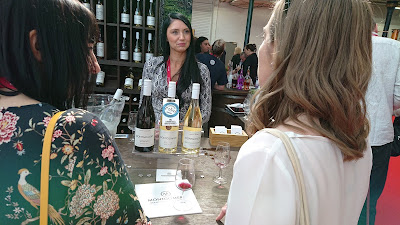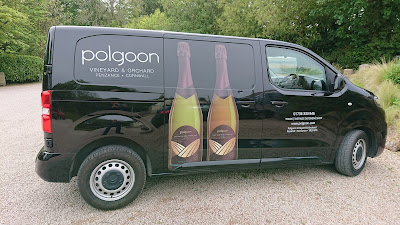It's not RAW, it's not RWF (Artisan Wine Fair and Real Wine Fair in case you are coming to this world of London wine fairs for the first time) - it's the more ordinary commercial LWF (no prizes for decifering).
Yet there are discoveries and surprises to be had here too, if you look for them.
 |
| Nikos Asteriadis of Oinoi Adam in his London debut |
 |
| photo we took at Oenorama in Athens 2014. |
The 2011 vintage came in at 14.5. The 2013 on show here is 15% but still showing the character of this great grape. This was surprise No. 1. Amazing.
Surprise No. 2 came from another Greek producer, Nerantzi whom we had not come across before.
Nerantzi makes a beautiful and individual wine from what they call an ancient Greek grape variety. It's called Koniaros. We are endebted to Markus Stolz for the following information:
Fact File Koniaros
Area grown: Serres, Macedonia, in the far north of Greece, close to the Bulgarian border. Currently Domaine Nerantzi is the only producer of a varietal Koniaros.
History: Koniaros is an ancient variety that had been left behind due to low yields. Nerantzi Mitropoulos came across vines in 1998. He had them DNA tested, registered Koniaros with the authorities, preserved and cultivates it.
Grapes: Large, thick skinned berries. Koniaros is a late ripening variety; harvest typically takes place in the last week of September.
Truly an amazing discovery. Nerantzi's Koniaros is already available in the USA from Flatiron and Astor among others. We can't imagine how we missed it on our many visits to those shops. It just shows that wine is such a vast topic that discoveries can be made almost everywhere.
Nerantzi had another surprise, maybe almost as dramatic: an Asprouda of Serres or Asprouda Serron. Asprouda means 'whitish' according to Wine Grapes so the many Asproudas need to be followed by a placeneme to distinguish them. For example
Asprouda Ariloghi
Asprouda of Chalkis
Asprouda Dopia
Asprouda Halkidos
Asprouda of Kynthos
Asprouda of Messenie
Asprouda Moureli
Asprouda Mykinon
Asproda Patron
Asprouda Santorinis
Asprouda of Spetses
Asprouda Zakyntho
Asprouda of Zanthe
All these grapes are different and make a whole range of wines from dry to sweet with different taste profiles. As Wine Grapes so aptly says 'DNA analysis is long overdue.'
Surprise #4, a whole booth devoted to a Ningxia winery.
Almost as recherche, Clwstwr Diodydd Cymru - Drinks Cluster, Wales. As well as Welsh Whisky etc. there were two wineries we had been unaware of: Montgomery and White Castle.
Montgomery Signature Wines of Wales make Solaris and a Solaris/Bacchus blend as well as Rondo.
This Rondo by Montgomery was simply the best Rondo we had ever tasted. It proved that you can make a really outstanding wine from this grape - sometimes regarded as only good for blending. What next? Rondo from the Rhonnda?
As if that wasn't suprise enough from Wales. next door was a rare example of a Siegerrebe in purezza. We had never tasted Siegerrebe before. We don't disagree with the description on the back label:
An aromatic elegant white wine with honey blonde and light straw hues . Layered sweet aromas of peach, orange blossom & nectarine, with ripe lychee on the palate and a long soft spicy finish.
Wine Grapes is not a fan ('Overpoweringly Muscat-scented, low acid...continues to decline, thankfully...can be overwhelming...) but perhaps they haven't tasted White Castle's Siegerrebe?
An emerging theme from recent posts on our blog has been the surprising re-emergence of some of our old 'mal aime' English and Welsh plantings from the early years. We had to admire a Cornish Schoenburger from Knightor Vineyard despite unpromising previous experience of this grape and it was a surprise to see the cool Ben Walgrave of Tillinghurst using Madeleine Angevine with obvious enthusiasm. The Rondo from Montgomery (above) can also be included.
And now, what was this? A concerted effort to promote Bacchus as our true national grape! Again we have had signs of this recently but here was a slew of examples from 9 producers.
Presiding with exemplary impartiality and enthusiasm was Ben Witchell, winemaker of Flint Vineyard. We had heard rumours that Flint was something special so we took a sip.
Could this have been yet another re-evaluation of a not so thrilling UK grape? Indeed. Flint Bacchus almost made us regret having torn up our own Bacchus this year - until we remembered the 10 backbreaking spray treatments we needed to give this susceptable variety last year (hardly a big mildew one). We mentioned this to Ben who gave us a wry smile. Ben has spent time in Beaujolais learning his craft. He has emerged in record time as one of the new generation of expert vignerons who are raising the bar for English and Welsh wine. He is the first to make a sparkling wine from the Charmat method - the one used for Prosecco. His vineyard is in Norfolk - sunny and dry. Berry Bros. and Rudd no less stock his wines.
Upstairs at 'Wines Unearthed' we found perhaps the biggest surprise of all.
On the face of it a Friulano from Friuli was not particularly extraordinary. The separation of 'Wines Unearthed' from those downstairs - some of which like the Koniaros were the epitome of unearthed - was random.
Since replacing our Bacchus with 'Soreli' this year, we have taken a renewed interest in Tocai Friulano or Friulano because Soreli is derived from that grape. It is one of Vivai Cooperativo Rauscedo's new resistant varieties.
Ever on the lookout for an actual wine from Soreli, we asked the gent at Zorzettig if he had heard of this new variety and if so wherther he knew anyone who had planted it.
 |
| Alan Gaddi of Zorzettig |
We are going to keep in touch. We doubt if our Soreli will come on stream as early as 2023/4 but you never know.
Now that was a surprise because Dr. Stefano Battistella, export manager of VCR was only able to name 2 nearby vineyards who had planted Soreli. One of these, Obiz in the province of Udine will bottle their first vintage this year.






















































